🎁 Free 30-day publishing fees on Pay-As-You-GO. Get 15% off when recruiting from the UserQ Panel, with code HELLO15

Gone are the days of manually sifting through mountains of data or relying on outdated user research methods to determine what users want from your products. Being a UX researcher in 2023 means tapping into the leading selection of user research tools available for brands and businesses to put to good use.
Say goodbye to heavy lifting…
The top 15 user research tools in 2023
Whether you’re a marketer, product designer, or brand owner who simply wants to know what makes your audience tick, we’ve put together a guide to today’s essential user research tools – ready and waiting to be put into action.
We’re now designing and developing digital products in an age where smart user testing tools can practically do all the heavy research lifting for you.
From AI-powered analytical tools to participant recruitment platforms, like our very own UserQ, this comprehensive list has got your UX research methods covered from start to finish.
Ready to boost your user insights and become the ultimate user researcher? Let’s get started.
What is user research and why does it matter?
UX research will always be a vital component of any digital product’s design and development process. Research methods like surveys, interviews, and usability tests (card sorting, tree tests, etc.) seek to understand the needs, behaviours, preferences, and opinions of the users that’ll experience your products first-hand. Without these, you run the risk of failing to build a final product that’s easy to understand and use – or just simply dislikeable.
UX research revolves around gaining insights that help you meet your users’ expectations and address their pain points.
In a nutshell, we think there are three leading reasons why UX research matters:
1. Helps you take a human-centric approach
UX research places people at the centre of your design process. It’s essential to understand and all-inclusively empathise with their needs and desires to genuinely resonate with them as emotional beings.
2. Increases customer satisfaction yet reduces risks and costs
Investing in user research early saves time and money in many different ways. Addressing potential issues beforehand minimises costly design changes later on down the line. Plus, never underestimate how a better product leads to satisfied users, positive word of mouth and ultimately increased brand loyalty.
3. Enhances your product’s usability and innovation
UX research is grounded in building a better user experience – hence the name! Insights into how users interact with a product tend to guide you into making smarter, more-informed improvements based on qualitative and quantitative data of a product’s overall usability. And knowledge of what’s working well produces a positive feedback loop for some thriving innovation, that stands you out as a top market choice.
Fortunately for us UX researchers and product designers, there’s a plethora of effective user research tools out today that help us grasp the good and the bad of a user’s experience – at all stages of the product’s development. But it’s important that we choose the right-kind-of tool or platform to help us out along the way.
Choosing the user testing tool for you
This depends on your budget, research objectives, the type of data you need, etc. When deciding, you should focus on key things like: what research method the tool facilitates, how easy it is to use, recruitment options, scalability, features, and its compatibility with your existing systems.
Ultimately, the perfect user testing tool should align with your specific research needs in order to get you the data and actionable insights you actually need.
And remember, the tool you opt for also depends on the design stage you’re at. For example, earlier on, you can prioritise remote research tools like card sorting and tree testing or exploratory tools that help conduct surveys or interviews. During concept testing, you can use usability testing tools – good for getting prototype feedback. Then later on when products are in their final stages we’d recommend analytical tools
That’s enough talk…let’s start exploring the top tools for user research in 2023.
Tools for usability testing
Whether you’re a marketer, product designer, or brand owner who simply wants to know what makes your audience tick, we’ve put together a guide to today’s essential user research tools – ready and waiting to be put into action.
We’re now designing and developing digital products in an age where smart user testing tools can practically do all the heavy research lifting for you.
From AI-powered analytical tools to participant recruitment platforms, like our very own UserQ, this comprehensive list has got your UX research methods covered from start to finish.
Ready to boost your user insights and become the ultimate user researcher? Let’s get started.
You can skip to the tools you need:
1. UserQ
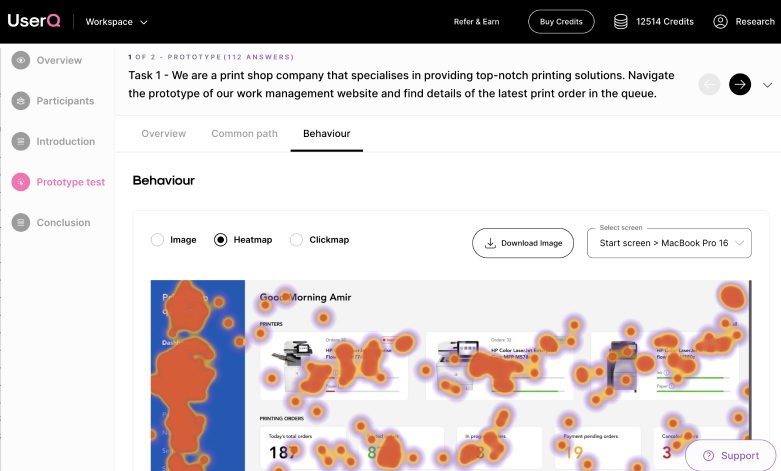
First up on our list of tools for user research: UserQ, AKA MENA’s first user testing platform that helps you make smart UX decisions in both English and Arabic. Whether you’re a product owner, researcher, designer, or marketer, UserQ gives you local insights practically at your fingertips – with comprehensive UX methods such as card sorting, tree tests, surveys, preference tests, and more.
They also have the UserQ panel: an extensive pool of 10,000+ quality testers across the MENA region who provide market-specific data filtered through a wide range of demographics. The use of this panel is priced via credits and each credit is worth $1. Prices per participant range from $2 to $6 depending on the method you’re using.
A go-to choice for: MENA-focussed user research
Recruitment options? yes
Language supported: Arabic and English
Stand-out features: simple-to-use tools, a UserQ panel with thousands of MENA participants.
Price: pay-as-you-go. Free 30-day trial when using your own participants. You can currently get 15% off when recruiting from the UserQ Panel. Simply use the code: HELLO15
2. Maze
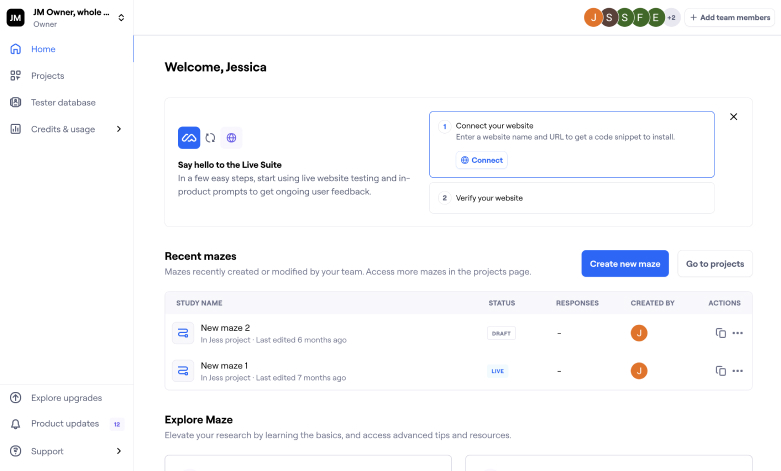
Maze is a simple research springboard with a wide variety of UX tools and functions for gaining UX insights. Think of it as a multi-purpose tool that’s all about building your confidence and helping you make better decisions as a researcher.
The site facilitates all sorts of in-depth tests including surveys, five-second tests, card sorting and more. You can also integrate prototypes and designs from practically all major design tools including: Adobe XD, Figma, InVision, Marvel, and Sketch.
A go-to choice for: in-depth reports and hassle-free pre-built templates
Recruitment options? yes
Language supported: multiple. More info here.
Stand-out features: remote testing real-time reports and pre-built templates.
Price: free for one project, then $75+ per month. Tailored plans are also available for organisations.
3. Userlytics
Userlytics is a user research platform which gives you access to nearly two million participants ready and willing to take part in your remote testing. It’s actually the world’s largest global UX participant panel – spread across 150 countries and a variety of languages.
The platform helps you hone in on qualitative and quantitative user insights by pinpointing your ‘persona’ through unique demographic criteria. Essentially it’s all about uncovering customer and user experience insights with your ‘perfect match’.
A go-to choice for: global participant recruitment
Recruitment options? yes
Language supported: Arabic and English
Stand-out features: moderated and unmoderated user testing, large two million participant pool, testing for mobile apps.
Price: enterprise plan means you only pay for usage. DIY plans start at $499+ per month. Custom plans are also available.
4. Optimal Workshop
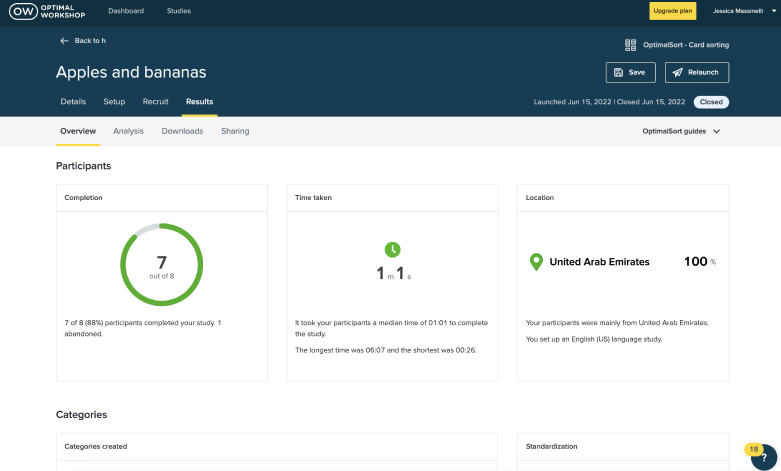
Next up on our list of top user research tools is Optimal Workshop. It offers five specialised tools for quick, actionable insights: card sorting, tree testing, first-click testing, online surveys, and qualitative research.
Optimal Workshop streamlines the whole research process by building ‘better digital experiences, backed by data’. You can also recruit participants from their in-app panel that’s fast and straightforward to use. Most importantly, you can filter your search with all sorts of target demographics including country, age, language, gender, and more.
A go-to choice for: quick and simple data-based user research
Recruitment options? yes
Language supported: 70 different languages. More info here.
Stand-out features: specialised usability tools, custom recruitment features, and multiple visualisation options for insights.
Price: free plans available (with limited usage) then $208+ per month plans. Custom plans are also available for enterprises.
5. Usability Hub
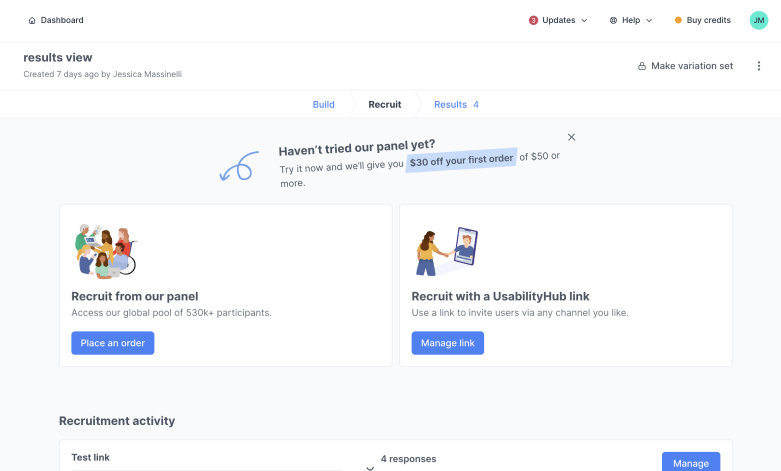
UsabilityHub is an end-to-end platform that builds the confidence of designers, marketers, and product designers looking to master their UX research. It’s a user-friendly tool that ‘takes the guesswork out of design decisions by validating them with real users.’ Its research method tools include card sorting, prototype tests, design surveys and more.
You can use your own participants or use their 530,000+ integrated panel that allows you to recruit participants according to your target audience. Panel prices start at $1 USD per response.
A go-to choice for: quick-fire and transparent user research
Recruitment options? yes
Language supported: multiple. More info here.
Stand-out features: comprehensive suite of tools, panel recruiting, average five hour turnaround.
Price: free plans available (with limited usage) then $89+ per month plans. Custom plans are also available for enterprises.
6. UserZoom
UserZoom is actually the world’s first UX insights system – and for that reason it’s thought of as the OG of remote user testing. It helps you to create digital experiences that delight users and ultimately grow your business.
As an all-purpose user testing tool, the platform offers no-fuss methods (including card sorting, live interviews, click testing and more) plus access to their global team of experts who can lend a helping hand at any stage of your research. Sometimes all you need is a few words of encouragement and a pro top tip.
A go-to choice for: beginner-friendly research with round-the-clock expert help
Recruitment options? yes
Language supported: multiple. More info here.
Stand-out features: multi-method testing, participant recruitment, global-scale insights, UX consultancy.
Price: available upon request.
7. dscout
Next up, dscout: a human insights platform that features a range of resourceful tools, from surveys to unmoderated research to participant recruitment. The platform is all about looking at your users as human – with emotional thoughts and feelings about your brand.
Their stand-out feature is probably dscout diary: a tool that facilitates live participant video and call interviews through the dscout platform itself – rather than having to jump on Zoom or other conferencing tools. It has got all sorts of handy functions too, including data tagging and the option to ask follow-up questions.
A go-to choice for: connecting with your human users
Recruitment options? yes
Language supported: English, Chinese, French, German, Japanese, Korean, and Spanish. More info here.
Stand-out features: participant recruitment, live interviews and surveys.
Price: available upon request.
8. UserTesting
UserTesting is one of the oldest user research tools in the game, and it continues to pioneer new methods of user testing tools – most recently with their User Testing Human Insight Platform: a video-first platform that allows you to see and hear the experiences of your users firsthand as they engage with your product prototypes and designs.
There’s also the UserZoom UX Research Platform for your remote user testing tools (card sorting, tree tests, etc.) and the EnjoyHQ Insights Hu: a digital space that facilitates team collaboration across your organisation.
Their whole motto is to help you understand what it’s like to be your customer – putting you in their shoes per se.
A go-to choice for: large-scale enterprises and big user research projects
Recruitment options? no
Language supported: Multiple. More info here.
Stand-out features: advanced targeting, real human interaction from 1:1 video-based research.
Pricing: available upon request.
9. Lookback
Lookback is another user research tool that allows you to talk face-to-face with your participants. Their usability platform means you can test your apps and websites with both moderated and unmoderated tests.
Whether it’s with a secured interview video call or a virtual observation room, Lookback researchers get real insights from real users to help you discover how they experience your digital products, completely from their unique perspective.
The platform is also easy to navigate with all sorts of helpful features like time stamped notes and team chats so you can organise and collaborate your research as you go.
A go-to choice for: interactive and moderated participant interviews
Recruitment options? no
Language supported: English, French, Spanish, Portuguese (Brazil) and Swedish. More info here.
Stand-out features: live broadcasts and observations, compatibility with web, IOS, and Android.
Pricing: plans range from $25 – $344 per month. All plans come with a 14-day free trial. Custom plans are also available for enterprises.
10. Crazy Egg
Crazy Egg is a user testing tool that specialises in heatmaps. The main heatmap tool is simple to use and gives you a breakdown of where visitors click on an individual page. All you have to do is add a small code into a page’s HTML and basically put your feet up while they track its progress and send you live results in snap-shot reports.
There are a few other tools too, including: user recording, feedback surveys, A/B testing, and basic site analytics that monitor stuff like where your visitors come from and what errors might be occurring.
A go-to choice for: heatmaps and scroll maps
Recruitment options? no
Language supported: English only
Stand-out features: heatmaps, scroll maps, session recordings, and traffic analysis.
Pricing: plans start from $29+ per month.
11. Loop 11
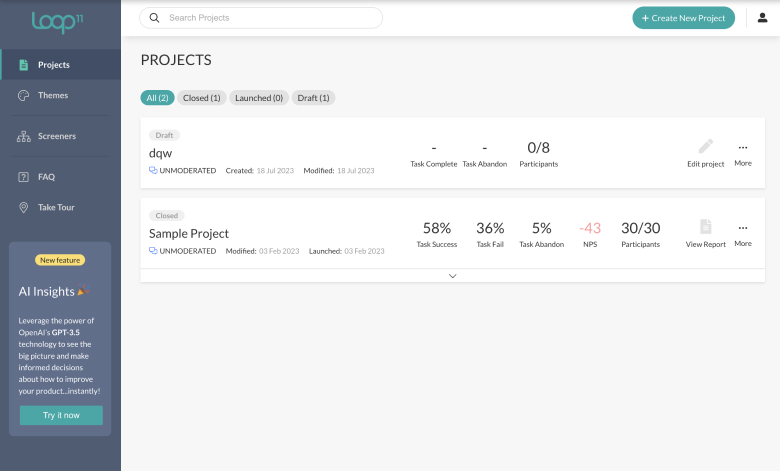
Next up on our guide to user research tools is Loop 11: a data-driven user testing tool designed to help you make smarter design solutions. You’re able to create usability tests in just 30 minutes by both building moderated or unmoderated projects – essentially recording a user’s first-hand experience of your products and then viewing the metrics in downloadable reports.
It’s all pretty straightforward stuff, making it one of the best tools for user research beginners looking to fully engage with their audience.
A go-to choice for: live website testing
Recruitment options? yes
Language supported: multiple. More info here.
Stand-out features: heatmaps, clickstream analysis, live website testing.
Pricing: plans range from $199 – 599 per month.
12. Hotjar
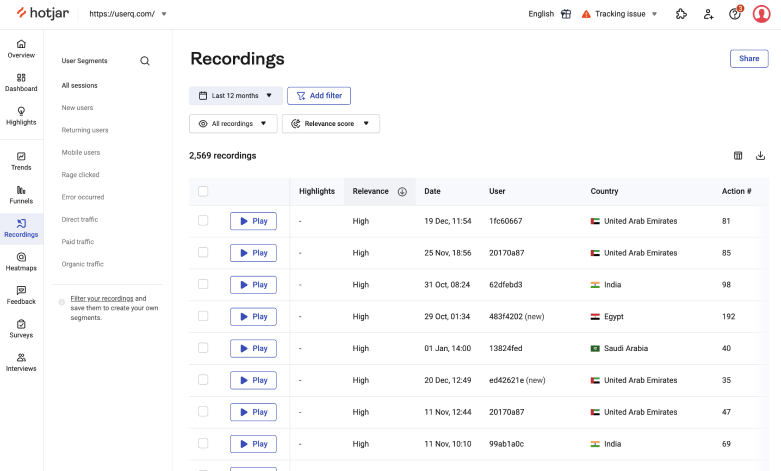
Hotjar is one of the best AI-assisted user research tools for gaining both qualitative and quantitative insights about your website (or app) – both in the form of behavioural data and valuable feedback via interviews and surveys.
The platform has analytical tools, like heatmaps, that visually represent clicks, scrolls, and motions – plus tools for you to ask contextual questions and hear from participants directly. It’s all centred around you gathering evidence and finding stuff out that standard analytical tools might not tell you.
Just note: there are no recruitment options, so you’ll need to find your own testers outside of the platform.
A go-to choice for: combining real-time data with qualitative feedback
Recruitment options? no
Language supported: multiple. More info here.
Stand-out features: heatmaps, interviews, surveys and data reports.
Price: free subscriptions offer up to 35 daily sessions. Plans then range from $32 – $171 per month.
13. PlaybookUX
PlaybookUX is a cloud-based UX testing platform – another tool offering moderated live interactions with testers. Through videos and interviews you’ll recruit for, conduct, and analyse both quantitative and qualitative research to help you capture people’s true reactions and opinions on your products.
The entire platform is designed to be an all-in-one kind of system offering a wide variety of research tools and functions: from card sorting to tree tests to super handy transcript notes that run alongside your video recordings.
One of their biggest draws is the pay-as-you-go option which means you’re not sucked into a subscription paying for what you don’t need.
A go-to choice for: a multi-purpose pay-as-you-go platform
Recruitment options? yes
Language supported: multiple. More info here.
Stand-out features: video-based feedback, card sorting and tree tests.
Price: Pay-as-you-go or plans ranging from $267 – $450 per month. Custom plans are also available.
14. Useberry
Userberry is a multi-purpose user testing tool that offers a diverse array of testing methods for validating ideas, designs and prototypes. From first-click tests to card sorting, to online surveys and loads more. It’s the perfect choice for researchers looking for a multitude of method options all under one roof.
The platform is specially built to make a researcher’s job easier too, with ready-made templates, an info-packed help centre, easy import and integration options, and different sorts of customisation tools.
A go-to choice for: having plenty of methods to choose from
Recruitment options? yes
Language supported: multiple. More info here.
Stand-out features: prototype testing and website usability testing.
Price: free subscriptions offer up to 10 responses per month. Then plans start from $67+ per month. Custom plans are also available.
15. Trymata
Last up on our list of user research tools is Trymata: a UX platform designed to help you build and test for the best digital experience possible. You can go down either the product analytics or usability testing route, making it suitable for a range of stages along the product development journey. It all revolves around taking your product to the next level of usability.
Through product analytics and various usability tests, you can monitor real-time user behaviour, pinpoint user frustrations, and build qualitative studies that provide in-depth feedback about what’s working – and what’s not.
A go-to choice for: a well-rounded UX research platform
Recruitment options? no
Language supported: multiple. More info here.
Stand-out features: live product analytics, remote usability testing and metrics tracking.
Price: Usability testing plans start at $399+ per month. Product analytics plans start at $300 per month. Custom plans are also available.
Summary
So there you have it, researchers and designers! Bear in mind this list isn’t supposed to be definitive. There are plenty of other premium user research tools out there that haven’t made the list, and are just as great at helping you build meaningful, more user-centric solutions for your digital products.
Remember, the main focus of any type of UX research is to help your brand make a positive and lasting impression on the humans it serves! After all, truly connecting with your audience is the driving force behind everything you do, right?
Related Post

Best practices for conducting remote
In this guide, we’ll let you in on UserQ’s top tips and tricks to utilise our selection of remote user

Start, Grow, Lead: A Guide
A career in which you can make a real difference to the everyday lives of customers and clients alike is

Validating your prototype FAQs: advice,
Ready to validate your prototype with our easy-to-use prototype testing tool? Well, we’ve got some must-hear advice and support to
Subscribe to our
product newsletter!
Receive emails about UserQ updates, new features,
offers and latest trends.


